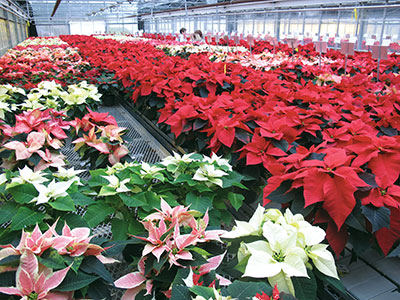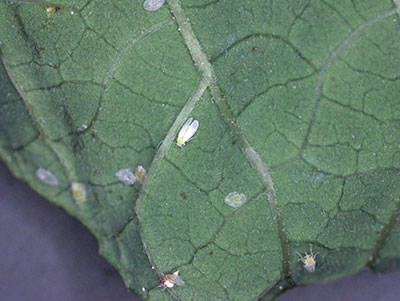
Features
Crop Protection
Inputs
Major threat of poinsettia
June 11, 2014 By Andrew Frewin and Graeme Murphy
Just as a forewarning, some of the technical information that follows may seem a little daunting, and the story is quite complex
Just as a forewarning, some of the technical information that follows may seem a little daunting, and the story is quite complex, but it is important to understand some of the background and the relevance to successful control of Bemisia in poinsettia.
 |
|
| Poinsettia has long been one of Canada’s largest potted crops. PHOTO COURTESY GRAEME MURPHY/OMAF/MRA Advertisement
|
Most poinsettia growers have probably heard of “Q biotype,” a relatively new strain of whitefly (in North America) that has been in the news for a number of years.
The initial thinking was that Q biotype belonged to a whitefly species called Bemisia tabaci.
Another strain of this same species was called B biotype (variously known as silverleaf whitefly or sweetpotato whitefly) and it has been a major whitefly pest on poinsettia since the late 1980s.
Q biotype has been present in southern Europe and the Middle East for many years where it has been a major pest on greenhouse vegetables.
RESISTANT TO A VARIETY OF INSECTICIDES
It is resistant to many commonly used insecticides, has a wide host range and can transmit a number of devastating plant viruses of greenhouse vegetable crops.
In late-2004, Q biotype was discovered on poinsettias in Arizona and in the following year (2005) was found in more than 20 U.S. states, often on poinsettia. Since then, it has been found every year (at varying levels) on poinsettias in mixed populations with B biotype.
The term “biotypes” needs some explanation here. It is a word used to describe different populations of the same species that show some differences in biological characteristics (in the case of Bemisia, for example, differences in pesticide resistance and ability to transmit viruses), but are otherwise identical in appearance.
In the early-1990s, soon after B biotype emerged as a pest of poinsettia, there was much debate in the taxonomic community (those scientists who identify and assign insects to their appropriate classification) about whether these “biotypes” are really the same species or are, in fact, different species. B biotype was eventually identified by North American taxonomists as Bemisia argentifolii based on differences in its DNA compared to other Bemisia populations.
TAXONOMIC CONSENSUS HAS BEEN REACHED
When Q biotype was found in poinsettias in Arizona, the taxonomic discussions were renewed, and it seems that a consensus has now been reached.
Current thinking is that the whitefly species originally known as Bemisia tabaci is actually a complex of 20+ cryptic species (cryptic meaning “hidden,” because they are impossible to tell apart based on their appearance) and that the term “biotype” is incorrect.
“Q biotype” is now thought to be the original Bemisia tabaci, which was first described in the 1880s. The other 20+ species in this complex don’t yet have names other than their “biotype” designations (with the exception of B. argentifolii as noted above), and “B” and “Q” cannot be easily distinguished from each other.
To make the story even more complicated, the scientific community now refers to these two species as “Mediterranean” (formerly Q biotype or sweetpotato whitefly) and “Middle East-Asia Minor 1” or “MEAM1” (formerly B biotype, Bemisia argentifolii, silverleaf whitefly).
However, for ease of understanding, it is probably easiest to refer to whiteflies (in the general sense) on poinsettia as simply Bemisia. When discussing the two species that have come to be known as “B” and “Q,” it is probably easiest to maintain those designations (again for simplicity), which we will do in the rest of this article.
The classical definition of a species is a group of organisms that can mate and produce fertile offspring. By this definition, “B” and “Q” should not be able to reproduce. What researchers have found, however, is that not only can’t they reproduce, but over time when mixed populations are maintained in cages “B” displaces “Q” until the population is completely “B.”
The reasons for this are thought to be related to mating interference between the two species, an interaction that favours “B.” Conversely, in mixed populations where pesticide pressure is applied, “Q” remains in the population. Recall that “Q” is more resistant to pesticides than “B.”
To return to the commercial poinsettia situation, between 2007 and 2011 many Ontario growers used biocontrol to manage their whitefly populations, with excellent levels of success.
At various times the populations were evaluated for the presence of “B” and “Q” – specifically in: 2007, when samples from seven greenhouses found that approximately 80 per cent were “Q”; in 2009, when samples were tested from two greenhouses, one of which was 100 per cent “B” and the other 100 per cent “Q”; and in 2010, when a single sample tested was 100 per cent B.
It should be noted that testing of Bemisia populations from poinsettia in the U.S. during the same period showed the presence of both B and Q at varying levels each year.
MAJOR ONTARIO SURVEY OF WHITEFLIES CONDUCTED IN 2012
In 2012, we decided to carry out a more thorough survey of whitefly populations in Ontario poinsettia crops to determine whether there were any differences in individual greenhouses resulting from different management practices. As it happened, that year proved to be a bad one for whitefly and in certain varieties of poinsettia, significant whitefly populations could be found even in the unrooted cuttings.
 |
|
| Bemisia adult.
|
Six greenhouses were surveyed every three to four weeks (July 5, July 29, Aug. 15, Sept. 11, Oct. 1 and Nov. 21) from the beginning of the crop when unrooted cuttings were first received, until November.
Three greenhouses used biocontrol as their primary strategy for whitefly management from the beginning of the crop and three used pesticides exclusively.
Additionally, a one-time survey of seven additional greenhouses was carried out at the end of the season on Dec. 12 (five of which had used biocontrol and two which had used pesticides). All whiteflies collected were brought to the University of Guelph and identified as either “B” or “Q.”
In the biocontrol greenhouses, the percentage of “Q” decreased to less than 10 per cent at the second monitoring date and could not be found at the third monitoring date in mid-August or any time thereafter.
By contrast, in the pesticide greenhouses, the proportion of “Q” decreased at the second and third monitoring, but then increased in subsequent samplings to finish the season at almost 40 per cent of all whitefly collected.
These results suggest that “B” is capable of displacing “Q” in a greenhouse environment in the absence of pesticide pressure.
Even in the pesticide greenhouses, the initial reduction in the proportion of “Q” over the first three sampling dates is likely due to the minimal use of pesticides during that early period of the crop. The first insecticide applications for each greenhouse were between Aug. 7 and Aug. 22. The increasing proportion of “Q” after the mid-August sampling corresponds to the beginning of pesticide use.
In the seven greenhouses that were sampled one time only at the end of the crop, 95 individuals were collected from the five greenhouses that used biocontrol. No “Q” individuals were found. In the two pesticide greenhouses, 24 individuals were collected, of which eight (33 per cent) were “Q.” The results from this one time sampling support the conclusions of the routine, season-long monitoring in the other six greenhouses.
The ability of “B” to displace “Q” under a biologically based management program may increase the effectiveness of pesticide clean-up applications if they are necessary. Even under a pesticide-based program, delaying the first application as long as possible could provide an advantage in terms of greater pesticide efficacy. This may be even more important if the starting population of whitefly has a greater proportion of “Q” than found during this survey. n
Andrew Frewin is a PhD student at the University of Guelph. Graeme Murphy is a greenhouse floriculture IPM specialist with the OMAF/MRA.
Print this page